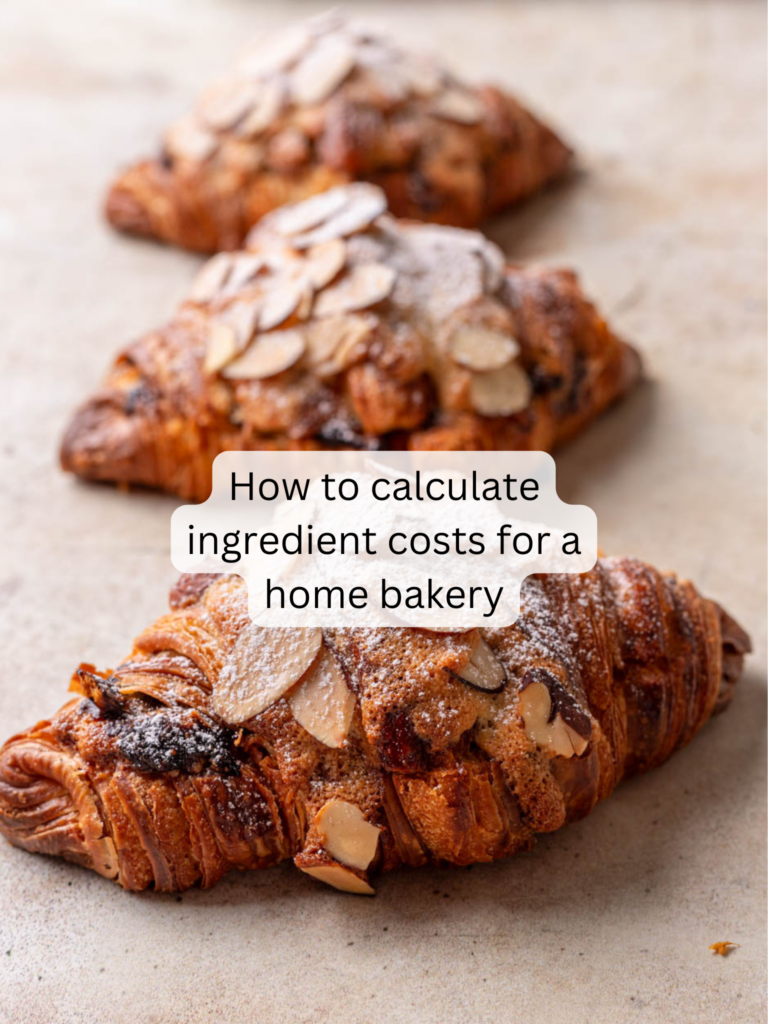Running a home bakery can feel daunting – not only do you have to find clients, follow your local food laws, and bake consistently delicious products, you also have to worry about business expenses and costs.
One of the fundamental things to understand is how much it costs to produce a bakery item. Not only will this help you with overall expense management, but it is also a key component of correctly pricing your products.
Home bakery ingredient costing template
Here is a TEMPLATE that lays out how I personally do costing for my home bakery.
Below is a step by step guide on why I structure things they way I do and can help you modify the template to your own business needs.
Step 1 – Standardize all recipes to kilograms
Start by taking all your recipes that you want to sell, and standardizing them to kilograms. Not only is baking by weight more accurate and consistent, but thinking about costs in grams and kilograms is much simpler than say, tablespoons, quarts, ounces, pounds, gallons etc..
Step 2 – Create a price table
A price table should include all the ingredients that you plan to use, and the cost of purchasing that ingredient. You want to standardize everything to kilograms, that way it can be easily matched to your recipe calculations.
For a home baker, your average purchase is not going to be neatly segmented into kilos. You might purchase a gallon of milk, or 25 pounds of flour.
For example, say you purchase 25 pounds of flour for $10. 25 pounds is about 11.3 kilograms. The cost per kilogram is thus $10 / 11.3 = $0.88.
If you live in an area that charges sales tax, make sure to include that in your prices.
Please see the Price Data tab in the template for reference on how to set up these calculations.
Step 3 – Identify the total cost for each ingredient in the recipe
Once you have the total number of kilograms for each ingredient in the recipe, and the cost per kilogram of that ingredient, identifying the total cost is simple!
Simple multiply the cost per kilo by the total number of kilos.
For example if the recipe calls for .5 kilogram of flour, and flour costs $0.88 per kilogram, you know that the total cost for flour in the recipe is $0.44.
Step 4 – Sum up the total cost of the recipe
Once you have the cost for each ingredient in the recipe, you can add them all together to get the total cost for one batch of the recipe.
You can also add together the total weight of all ingredients to get the total weight of one batch of the recipe
Step 5 – Calculate the ingredient cost per item
Now you know how much it costs to produce a single recipe batch. However, you probably want to know how much it would cost to produce just one item.
There are multiple ways to go about this.
Method 1 – if you know that a single recipe batch makes a set amount of product, you can divide by the total recipe cost by that number. For example if it costs $6 to make 12 chocolate chip cookies, then the cost per cookie would be $0.50.
Method 2 – if you know the amount of recipe that goes into a product, you can calculate the cost per gram then multiple by the total number of grams. For example if 500g of cookie dough costs $5 to make, I know each g costs $0.01. If each cookie is sized at 50g, then the cookie would cost $0.50 to make.
I prefer method 2 – its a little bit more math, but gives me flexibility if I decide to change the size of the product.
Adding a waste factor
I also include a “waste factor” when calculating the cost per item, which simply assumes the real cost is higher than what I’ve calculated. This takes into account things like cookie dough left on the side of the bowl, accidents, or simply not selling everything you produce.
Update your ingredient cost model
Your ingredient cost model should be regularly updated to best reflect the current price of ingredients. That way, you aren’t working with outdated information and know if you need to change your prices.


This is really helpful!!